
This is home. In the two years she’s lived in Rogers Park, Moorthy says neighbors have become friends, and she’s built a community. That’s despite the coronavirus pandemic and shutdowns. She regularly walks along Lake Michigan and picks up produce from local markets that remind her of her native India.
“I definitely feel very much at home in Chicago,” says Moorthy, 40. “It’s my chosen home in the U.S., and Rogers Park has been really healing and home-like for me.”

Rogers Park not only is one of Chicago’s most diverse neighborhoods. It most closely matches the racial and ethnic breakdown of the entire city, according to a Chicago Sun-Times analysis of 2020 census data.
More than 55,600 people live there, with 40% of them identifying as white, nearly 23% as Latino or Hispanic, nearly 25% as Black and about 7% as Asian American, according to the Sun-Times analysis.
Citywide, 31% of all Chicagoans identify as white, nearly 30% identify as Latino or Hispanic, about 29% as Black and nearly 7% as Asian American.
Welcome to "Little Chicago"
Based on a Sun-Times analysis of 2020 U.S. Census data, the racial and ethnic makeup of Rogers Park most closely resembles Chicago’s overall makeup more than any other community area. At least 51% of the blocks don’t have any racial or ethnic majority, and of those that do, 32% are majority white, 11% are majority Hispanic and 6% are majority Black.
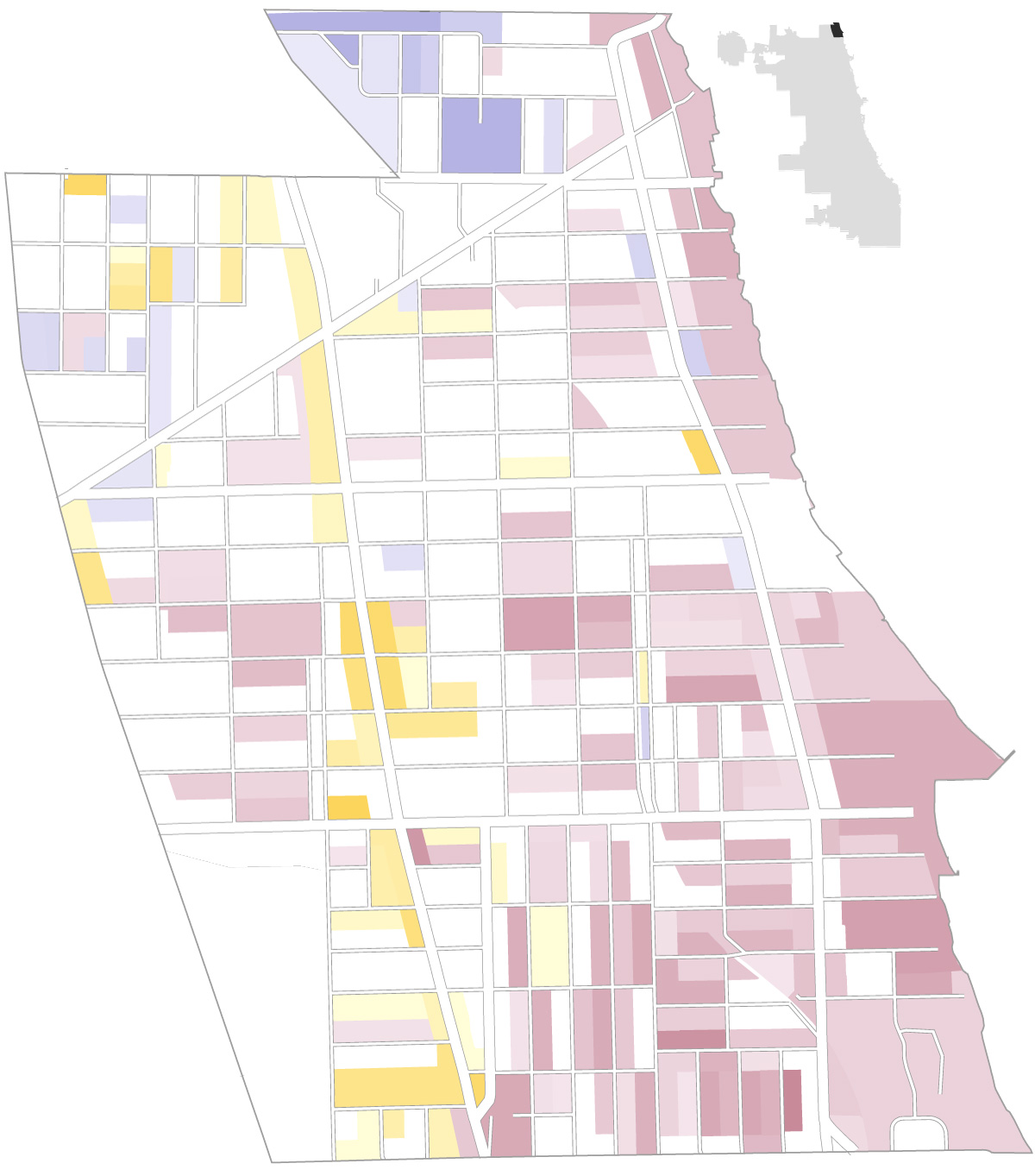
University S&C
Electric
Company N Rogers Ave Touhy Ave N Sheridan Rd W Pratt Blvd N Clark St Pottawattomie
Park Loyola
Park Loyola
Beach Lake
Michigan ROGERS
PARK Rogers
Park Chicago
A recent report from the U.S. Census Bureau found that Illinois’ population was undercounted in the latest census by more than 250,000 residents.
It’s unclear which parts of the state were most severely undercounted, though immigrant, racial and ethnic minority households historically have been undercounted.
Just as they have done across the city, immigrants have been influential in shaping the culture of Rogers Park. Immigrants have lived there since its early days as a neighborhood, according to Dona Vitale, community outreach chair for the Rogers Park/West Ridge Historical Society. And, just as immigration trends have changed nationally over time, so have the places people have come from to live in the Far North Side community, Vitale says.
On a stretch of busy Clark Street, one of the neighborhood’s key commercial thoroughfares, restaurants feature kosher meats, traditional Ethiopian dishes and Mexican food, among many other types of ethnic food offerings.
Vitale says she thinks the housing available in Rogers Park has been key to keeping the neighborhood diverse. She points to the mix of housing — from elegant, historic homes to large apartments for families — and how people have pushed for new developments to include affordable housing units.
There are college students, including those attending Loyola University Chicago and, just to the north in Evanston, Northwestern University.
“Young people come in and kind of start with an apartment for students or people who got out of school, and it’s what they can afford,” Vitale says. “Then, they move but move down the block to a better condo. A lot of people come and would like to stay within the community — that increases the diversity, too.”
About half of the city blocks within the neighborhood don’t have a majority racial makeup, reflecting how racially diverse they are, the Sun-Times analysis found.







But, as in other parts of Chicago, blocks along the lakefront and closer to Loyola tend to be majority white. In other parts of the neighborhood, farther from Lake Michigan, racial and ethnic groups tend to live together.
Around Clark Street, some blocks are majority Latino, and the northernmost part of the neighborhood has majority Black blocks.

Where Moorthy lives, residents range from students to families, from Black to white to South Asian. She says “it just feels good” living there.
These are some of the places in Rogers Park that offer an idea of the community’s broad diversity:
Devon Market
1440 W. Devon Ave.

Walking in to Devon Market near Rogers Park’s southern boundary, customers are likely to hear a variety of languages — though often not English — spoken in the aisles. Customers make their way through the produce section to find fresh baked pita breads and coffee. A refrigerated display offers to-go options that include shawarma made with an Israeli spice, Greek-style dolmas, Korean noodles, Russian-style sweet pancakes and spicy Mexican salsas.
“It’s beautiful,” Shaul Basa, who owns the grocery store, says of the mix of languages and cultures. “I love it. I’m lucky. I meet a lot of people, talk to a lot of people. It’s great.”
Basa opened the store 22 years ago, at the time figuring that most of the customers would be South Asian because of the community already living along Devon Avenue. He soon found he needed to adapt to also serve people arriving from Eastern Europe and later from the Middle East and Arab nations.
Speaking English isn’t a requirement to work there. Basa remembers knowing very little of the language when he first came from Israel and settled in the United States.
Having workers from such diverse backgrounds means he’s always getting suggestions about what might do well with customers from different communities.
One recent afternoon, Rimi Alkhilel was working at the back of the store, preparing baklava from a recipe she and Basa created that reflects the way her family made it in her native Iraq.
Loyola Beach
1230 W. Greenleaf Ave.
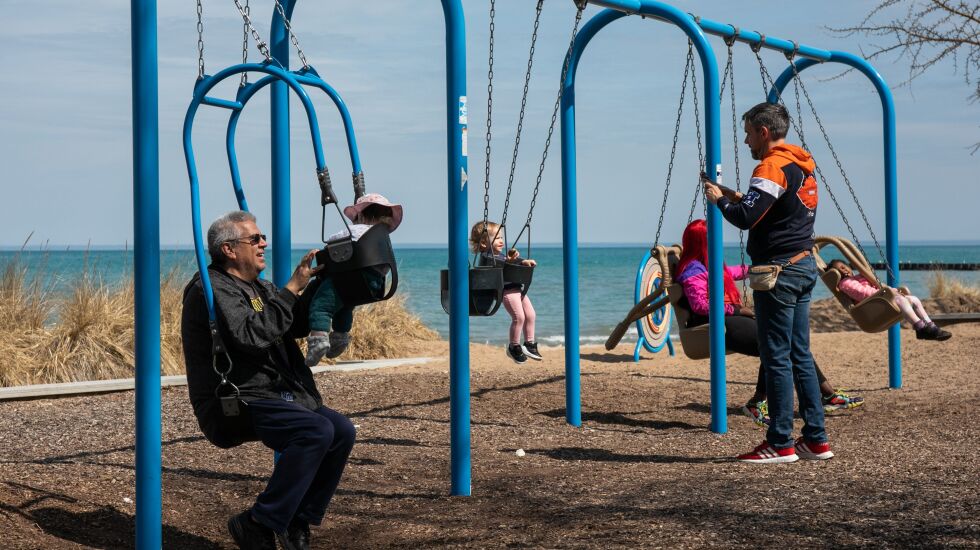
Sharya Shah, a student at Loyola, lives off-campus in Rogers Park.
Shah, 21, says she likes that the area is close to campus and not that far from the Loop but still doesn’t feel as busy as other parts of the city.
As she walks along the pier at Loyola Beach, other people are playing basketball at the lakefront park, a man and a woman dance along a path, and others are having a picnic.
In her apartment building, there’s a mix of college students, young families and older people.
“There’s a big, diverse community, and everyone’s really welcoming and really nice to each other,” Shah says. “The closer I get to campus, I will see people sticking to themselves. But further from campus, everyone’s kind of living their lives.”
International Society for Krishna Consciousness Chicago
1716 W. Lunt Ave.
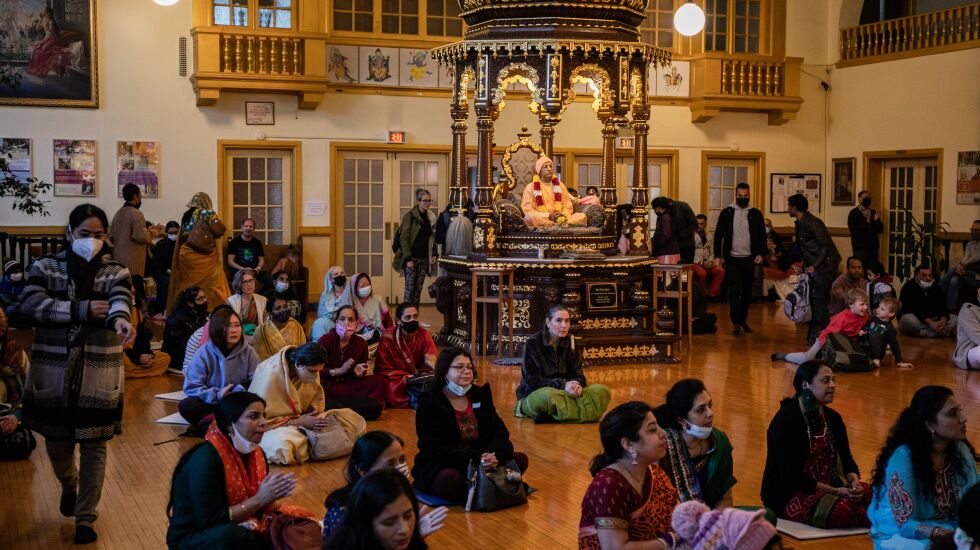
Chants of holy names echo through the temple of the International Society for Krishna Consciousness Chicago in Rogers Park on a Sunday as devotees gather for Ram Navami.
Sitting on the floor inside a large room, the group’s chants follow the rhythm as they face an intricate altar adorned with flowers. It’s a celebration open to all. Some meditate. Others sit on benches along a wall.
“Every Sunday, we have a festival where we introduce our culture to the people in general,” says Balaram Das, who is a council member for the temple. “So we have all kinds of people who come to the temple. This is a unique opportunity for them to know about our culture — what we do, how we connect to God.”
ISKCON, also known as the Hare Krishna movement, focuses on philosophy, food and yoga. The temple — which moved from Evanston to Rogers Park in 1980 — includes a kitchen to make vegetarian meals the group shares, space for children to learn to play the mridanga, a drum from India that’s used during festivals, and an area to practice yoga.
Gaya Barthaki temporarily lived at the temple when she first moved to Chicago from Atlanta. She soon settled in an apartment not far from the temple so she could be close to the community.
“This is the place where I feel at home,” she says.
Athena Board Game Cafe
1418 W. Howard St.
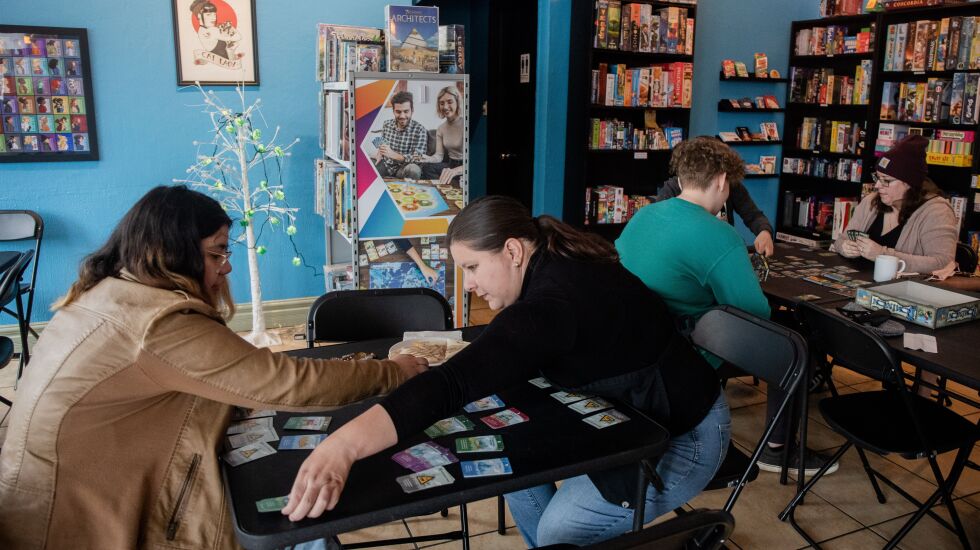
Patricia Gonzàlez spent days driving around Chicago to get a feel for different neighborhoods before deciding to live in Rogers Park.
She liked its proximity to public transportation and its colorful murals and the affordability, especially since she wanted to start a business. In May 2020 — just months into the coronavirus pandemic — Gonzalez opened Athena Board Game Cafe on Howard Street near Sheridan Road.
“This is a little bit my oasis, where things are simple,” says Gonzàlez, who has kept her full-time job while also running the cafe. “We’re here to have fun. I’m here to help people have a good time.”
The cafe sells grilled cheese sandwiches, lattes and milkshakes, but the big draw is the variety of international board games people can play for as long as they want for $5, Gonzalez says.
Families come to play. Couples on dates, too. Many of the board games include picture and number instructions, so language isn’t a barrier. The cafe hosts gaming socials. Gonzàlez says she hopes to have community nights when people won’t have to pay $5 to play.
Gonzalez got into board games to bond with her daughter, who’s now in college. On a trip to London, they visited a board game cafe. That gave her the idea.
“That’s something that I try, through social media, to show to people that really anyone can come here and find something to play,” Gonzalez says.
Caribbean American Baking Co.
1539 W. Howard St.
At the Caribbean American Baking Co., Leroy Viamille, a longtime Rogers Park resident, stops in after meeting with a real estate client, grabbing a late lunch of a vegetable pattie that costs less than $3.
“They support the community, which I’m happy about,” Viamille says. “They’ve always been a good blend of the community. The owner has always been here, and he’s kind of stable before this neighborhood was the neighborhood it is.”

The bakery specializes in Jamaican-style patties and hard dough bread. In business since 1982, it’s run by Michael Humes, whose parents, Jamaican immigrants, opened the store at a time the area along Howard Street was home to a large Jamaican community.
The loafs of hard dough bread are made in-house and help tame the spices of the jerk chicken meals sold on weekends, Humes says. The bakery also sells to restaurants, though demand has fluctuated throughout the pandemic.
Tony Brown, who grew up in Rogers Park, stops by the bakery to pick up a jerk chicken dinner before heading home to Hyde Park. He likes to drive through the neighborhood on his way home from work in the north suburbs.
“It’s one of the last neighborhoods that’s kind of close to the lake and beach,” Brown says.
Romanian Kosher Sausage Co.
7200 N. Clark St.
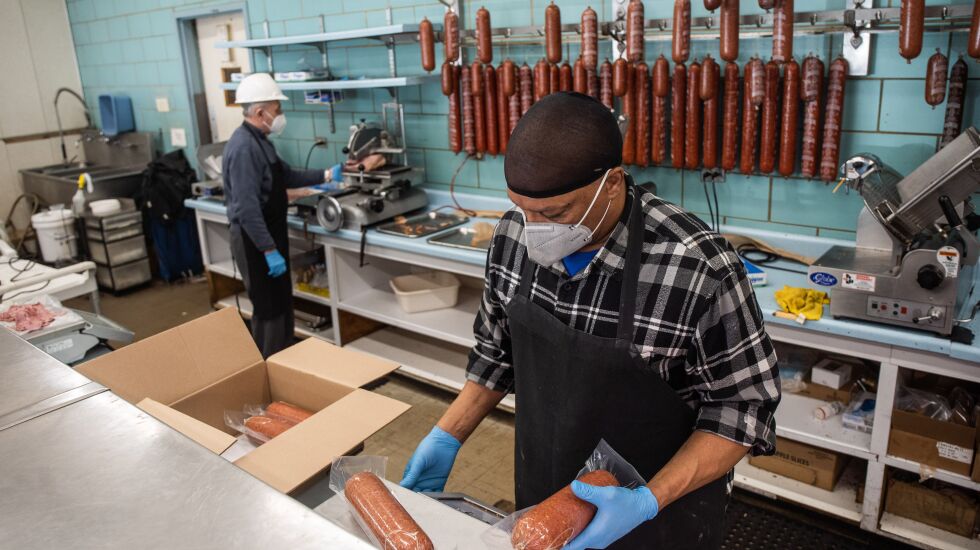
Since 1964, Romanian Kosher Sausage Co. has been in business on Clark Street at Touhy Avenue in Rogers Park.
The business, which specializes in kosher sausages and smoked meats, has seen the neighborhood change from predominantly Jewish to Latino to African American, says Richard Levin, manager of the family-owned business, which also sells its offerings online. The majority of its customers are still Jewish, but it also gets customers from other backgrounds.
Levin boasts of the sausages, saying: “It’s a more wholesome product because there’s no fillers in it. We don’t try to make a higher profit by putting in all kinds of artificial fillers. Our hot dogs and items are beef and spices — that’s it.”
Taste of Peru
6545 N. Clark St.

People come to Taste of Peru mostly for traditional South American dishes like lomo saltado. During the pandemic, though, they’ve also stopped in to the Rogers Park business that’s tucked in a strip shopping center for advice about vaccines.
Sara Izquierdo, the restaurant’s manager, says she got vaccinated as soon as she could and tried to help her neighbors, many of them immigrants and refugees, navigate how to get inoculated against COVID-19.
“Being in a scary situation, especially being away from your family, you saw people come together in ways that I had never seen before,” she says. “Neighbors helping neighbors.”
Her father Cesar Izquierdo opened Taste of Peru in the late 1990s with help from his mother, who made sure the menu included traditional Peruvian dishes.
Cesar Izquierdo says that, early on, community events in the area often focused on crime and making sure meetings were translated to Spanish. In recent years, Sara Izquierdo has helped organize know-your-rights meetings for undocumented immigrants.
The pandemic has tested the business, and one customer gave the family a personal loan. Though they’ve been able to return to in-person dining, the Izquierdos are still grappling with an increase in food costs.
But they’re planning to stick around, even as they think about opening a second location.
“I think it’s really an undervalued neighborhood,” Sara Izquierdo says of Rogers Park. “I don’t like when people say, ‘It’s up-and-coming.’ We’ve been here. You guys are just noticing us now.”
Residents of Rogers Park Instagram
After months of uncertainty because of the pandemic, Iman Music and Leah Schiffman, friends since elementary school, were at a park in Rogers Park and, inspired by seeing people hanging out there, decided to pursue a photo project about the neighborhood.
The resulting “Residents of Rogers Park” on Instagram showcases stories about people living there and offers glimpses of some of the neighborhood’s gems.
“It’s a combination of everything beautiful in Chicago in one small place,” Schiffman says of the neighborhood. “Something I took for granted.”

Music says her family isn’t Jewish but frequented a Jewish deli in the neighborhood when she was growing up.
She says the community can feel like a cultural exchange.
“Somehow, Rogers Park captures the beautiful part of it,” Music says.
Freddie’s Modern Kung Fu
1642 W. Howard St.

When Freddie Lee made a career change about 12 years ago to teach martial arts, he found an affordable location for his new business on Howard Street in Rogers Park that was a short walk from where he was living.
At Freddie’s Modern Kung Fu, Lee, 40, does personal training and holds martial arts classes for adults and children from a wide range of backgrounds.
“It feels like this is Chicago to me,” Lee says of the neighborhood. “Yeah, there are crime problems. To me, it’s been getting better, specifically my street on Howard.”
Contributing: Jesse Howe, Andy Boyle
Elvia Malagón’s reporting on social justice and income inequality is made possible by a grant from The Chicago Community Trust.














